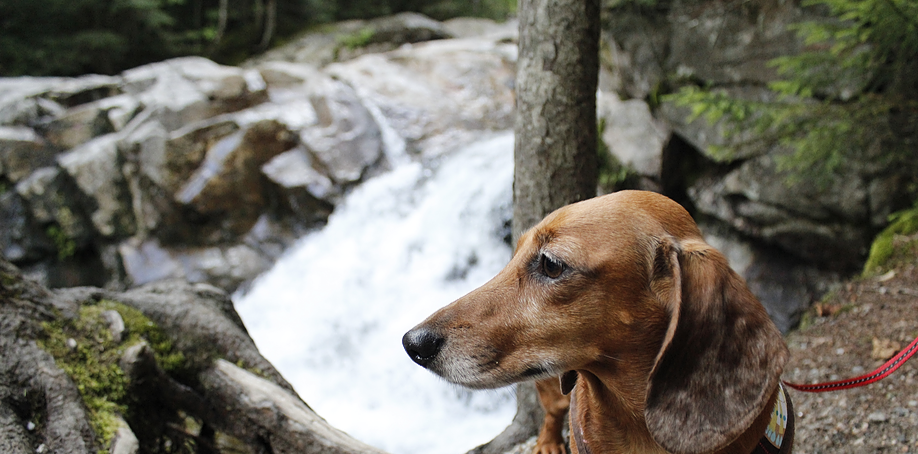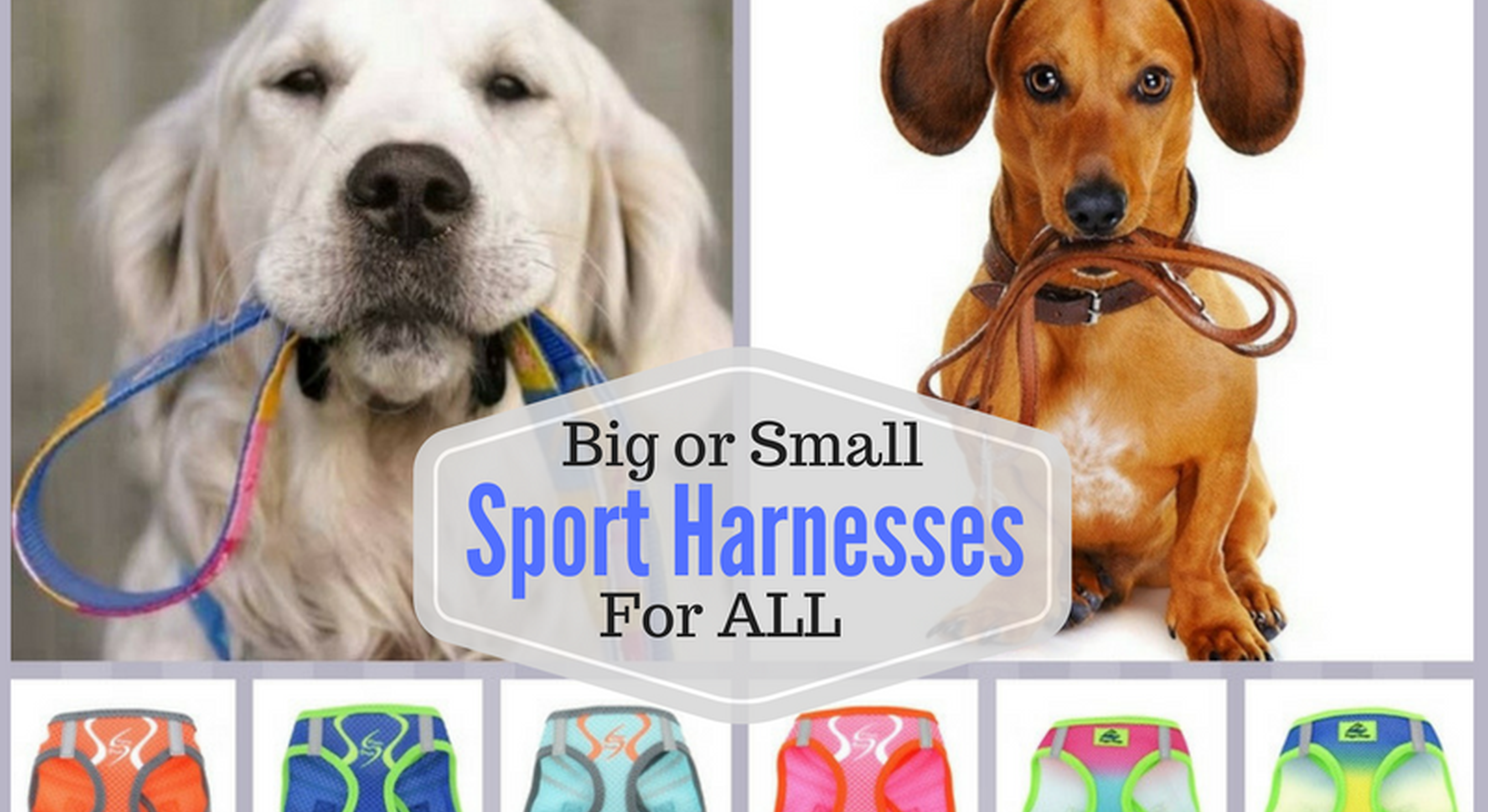Going for a Hike?
Good planning makes hiking with your pet a rewarding experience for the both of you. Walking and Hiking provides great exercise, plus allows you to spend quality time with your best buddy. Be prepared and Select the right type of safety harness that's easy to put on off.
Harnesses come in a variety of styles so whether your pet favors a step in vest or over the head halter or wrap-a-round pack, be sure to make the right choice that best fits your pet. First, always measure your pet around its girth (chest) and Neck. Fit should be snug not tight but then again not too loose. Good rule of thumb is if you can't put your finger inbetween your pet and the harness it's too tight, but then again if the harness looks droopy or shifts when your pet walks it's too big. If your favorite harness style is a halter make sure it will fit over the pet's head. some dogs have heads that are a bit wider than their necks and over the head may not be a good choice. Always refer to sizing charts for best fit.
Make sure there's a heavy duty D-ring to attach to a walking leash, retractable long length leashes are great when going on hikes. Remember to give your pet lots of leeway for walking about, but not too much that it needs tugging or pulling back. Keep them close to you especially if there are other hikers about. Being friendly is fine but getting into someone else's space could be iffy.
Remember: Always bring water, a collapsible bowl, some treats, a few baggies for quick cleanups, pet friendly organic bug repellant or flea/tick collar of choice.
WOOF! Take plenty of breaks for water and snacking. Don't overexert yourself or your pet ...
AND don't forget to take lots of selfies and enjoy the scenery around you.Pictured: Daisey is wearing the Spring Garden Step in Vest find it other colors here
Check out our Harness Collection and choose your favorites from wooferful choke free styled Step-ins or Halters or Wrap-a-rounds. Specialty Leashes also available here
info@daiseysdoggie.com
Remember to Take Pride and Keep the Environment clean --- Don't Forget Baggies. There's nothing less appealing than stepping into stuff left behind from pet travelers who came before you. Be mindful of those who come along after you on your hikes and walks. Be considerate pick up after your pet. Remember to keep on hand clean up supplies and help keep the environment clean so that others to enjoy their outings too -- Stock up on waste pick up supplies
What and How Better Safe than Sorry
Plan
- Start on small hikes or walks to train your dog first then slowly increase the distance
- If you plan on having your dog (large sized dogs) carry a backpack, be sure to condition your pet by first getting it accustomed to carrying small weight loads then increasing weight as your pet becomes conditioned
- Don’t forget to check with your veterinarian to make sure your dog is up-to-date on his/her vaccines
- Get a good leash for securing dog while hiking
- Be sure that dogs are allowed on the trails you plan to hike
- Don’t feed your dog a large meal before a hike (plan to give it small portions throughout the hike instead)
- For dogs with arthritis or medical conditions, consult your veterinarian before planning a hike
- Take note of the nearest emergency veterinary clinic in the area.
- If your pet isn’t already microchipped consider properly microchipping before you head out on a trip
On the Trail
- Plan your day according to the terrain and Keep walks to a reasonable pace and distance.
- For smaller or older dogs, forego an overly strenuous hike.
- Keep your dog on a leash while hiking.
- Try to hike in areas where there is shade and some water along the way for cooling paw pads
- Avoid hiking during the hottest part of the day and keep walks to a reasonable pace and distance
- Avoid areas that permit hunting.
- Steer clear of poison ivy, oak and sumac (look for leaves of three)
- Stay away from critters such as snakes, porcupines, bears, mountain lions and coyotes
- Make Frequent stops to Allow time for rest and water breaks, preferably in a dry area with shade
- Watch for signs of overexertion, such as excessive panting, drooling, weakness or bright red gums
- Look out for hypothermia, frost-nip, injury to paw pads, lameness and exhaustion
Supplies
- Fresh water and a collapsible bowl
- Food and treats
- Current ID tags and a well-fitting collar or harness
- A sturdy leash for walking or securing your pet to a specific area
- A roll up bed or blanket to lie on
- Doggie bags for waste
- Pad protective booties for rocky/rough terrain, snow, ice, cacti or nettles
- First aid kit
- Towel to clean your dog
- Snake bite kit (if appropriate for your area)
- Dog sunscreen/hat and bug repellant
- For larger sized Dogs: Doggie backpack for sharing the load. Use only if your dog is used to doing this.
Protection for your Pet
Don't forget to safeguard your pet against Flea & Ticks
Always check your pet for any signs of ticks after a day outdoors, whether hiking a trail or out and about in Nature Walks. Flea & Tick Season typically is a higher risk during the months of March thru October, but depending on the climate you live in it can be year round.
Always use Veterianarian recommended flea & tick repellant & preventative products to safeguard your best Buddy.
CHOOSE YOUR Pet's Favorite Styled HARNESS

HALTER Styled
Choke Free Halter Styled Harnesses http://bit.ly/2oQhTFt offer greater range of size for chest width flexibility. Halters come in a variety of patterns and colors. They come in mesh fabric, sturdy wovens and some are lined in faux fur, while others offer fashion hoodies. Halter Harnesses Features like: Choke free pull, heavy duty D-Ring for leash attachment, adjustable side straps with wide range of width and secure buckle closures. Halter styled harnesses go over the head and have a fixed width that fits the majority of pets and are a favorite for most pet owners. However, some pets have larger heads than neck make sure you measure your pet http://bit.ly/2oByblo according to mfg. size charts so that the halter can fit over their heads comfortably. Available for pet sizes XXS thru 3XL.
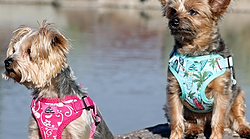
Choke Free Step in and wrap around vests http://bit.ly/2oGv6jO come in a variety of patterns and styled vests. They are available in mesh, sturdy wovens, contrast lined or soft faux fur lined. Wrap and snap vests offer adjustable side and shoulder straps, while Step in Vests offer secure one-piece vest fit. Step in Vests feature: Choke free pull, velcro closure wrap, heavy duty D-Ring, Secure buckle. Step in Vests fit more snugly and do not offer wide range of width adjustment. They are meant to fit pets much like a vest or jacket. While Step ins offer a one-piece suit like fit they may not fit all pet body types. http://bit.ly/2oByblo
When measuring your pet compare those to the size charts, if your pet's measurements are borderline with the mfg. size charts go up or down a size accordingly. Available for pet sizes XXS thru 3XL
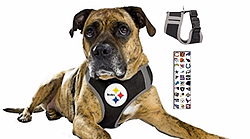
Sports themed Harnesses for the NFL sport Fan. http://bit.ly/2oiCLSJ Much like regular Halter Harnesses they offer good range of size chest width flexibility. Choice of official licensed authentic NFL Team Logo. Halter Harnesses Features include: Choke free pull, heavy duty D-Ring for leash attachment, adjustable side straps with wide range of width and secure buckle closures. Halter styled harnesses go over the head and have a fixed width that fits the majority of pets and are a favorite for most pet owners. However, some pets have larger heads than neck make sure you http://bit.ly/2oByblo measure your pet according to mfg. size charts so that the halter can fit over their heads comfortably. Available for pet sizes XXS thru 3XL.
f p t w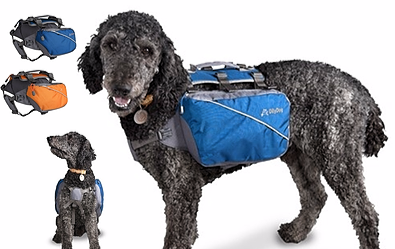
Backpack Dog Pack Harness allows pets to carry in optimal weight distribution designed for pet's comfort.
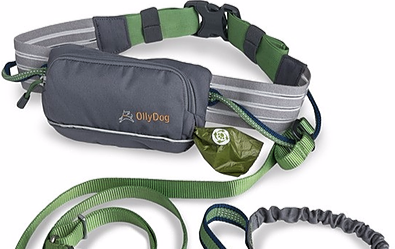
Hand's Free Belt Pouch with Soft Pull Leash.



